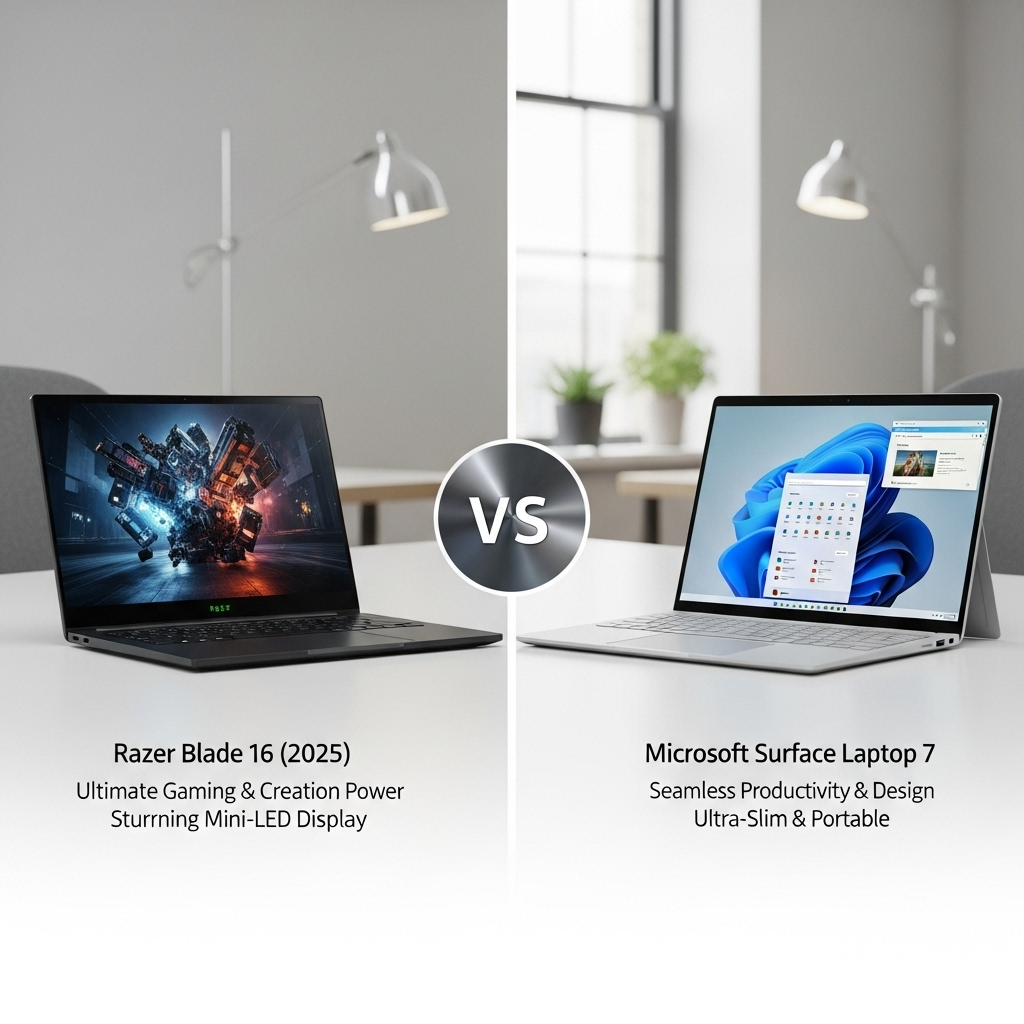Laptops: Razer Blade 16 (2025) vs. Microsoft Surface Laptop 7
Quick Verdict
The Razer Blade 16 (2025) is a gaming powerhouse, while the Microsoft Surface Laptop 7 is a more balanced option for productivity and portability.
- Razer Blade 16 (2025) offers high-end gaming performance with a dedicated NVIDIA RTX 5000 series GPU.
- Microsoft Surface Laptop 7 prioritizes battery life and portability with Qualcomm Snapdragon processors.
- Both laptops have non-upgradeable RAM.
- Surface Laptop 7 features a removable SSD, while the Razer Blade 16 does not.

Key features – Side-by-Side
| Attribute | Razer Blade 16 (2025) | Microsoft Surface Laptop 7 |
|---|---|---|
| Screen Size | 16-inch | 13.8-inch and 15-inch models |
| Display Resolution | 2560 x 1600 (QHD+) | 13.8-inch: 2304 x 1536 (201 PPI), 15-inch: 2496 x 1664 (201 PPI) |
| Refresh Rate | 240Hz (up to 253Hz overclocked) | Dynamic up to 120Hz |
| Processor (CPU) | AMD Ryzen AI 9 HX 370 / Ryzen AI 9 365 | Qualcomm Snapdragon X Plus / X Elite |
| Graphics Card (GPU) | NVIDIA GeForce RTX 5090 (Mobile) / RTX 5070 Ti / RTX 5080 | Qualcomm Adreno GPU |
| RAM | 32 GB LPDDR5-8000 (up to 64GB) | 16 GB, 32 GB, or 64 GB LPDDR5x |
| Storage Capacity | 2 TB PCIe 4.0 SSD (up to 4TB) | 256 GB, 512 GB, or 1 TB removable Gen 4 SSD (up to 2TB) |
| Battery Life (in hours) | 5.35-8 hours | Up to 20-22 hours (video playback), 15-16 hours (mixed usage) |
| Weight | 2.14 kg (4.71 lbs) | 13.8-inch: 1.34 kg (2.96 lbs), 15-inch: 1.66 kg (3.67 lbs) |
| Price | $3,000 - $4,900 | $999 - $2,499 |
Overall Comparison
GPU: Razer wins; Battery: Surface wins; RAM: Both soldered; Storage: Surface removable SSD
Pros and Cons
Razer Blade 16 (2025)
Pros:
- Effective cooling system with a large vapor chamber and fans
- Prevents thermal throttling
- More portable than its predecessor due to its thinner and lighter design
- Slim 0.59-inch profile at its thinnest point
- Superb build quality
- Unibody chassis, precision cut from a single block of aluminum to minimize size without compromising strength
Cons:
- RAM is soldered and not upgradeable
Microsoft Surface Laptop 7
Pros:
- Premium build quality with an anodized aluminum body
- Display has two color profiles: sRGB and Vivid (DCI-P3), both with a Delta E accuracy of 1.14-1.15
- Factory calibrated display with Dolby Vision IQ/HDR support
- Trackpad rated as '90% there' compared to MacBooks
- Removable Gen 4 SSD storage
- Improved performance and compatibility compared to earlier ARM-based Windows devices
- Updated x86 emulator (Prism) for running non-native apps
- Adobe is rolling out ARM native apps for Photoshop and Illustrator
Cons:
- RAM is integrated and not upgradeable
- Keyboard has shallow key travel
User Experiences and Feedback
Razer Blade 16 (2025)
What Users Love
- No highlights reported.
Common Complaints
- No major complaints reported.
Value Perception
- No value feedback reported.
Microsoft Surface Laptop 7
What Users Love
- No highlights reported.
Common Complaints
- No major complaints reported.
Value Perception
- No value feedback reported.
User Recommendations
- One user reported 15-16 hours with mixed usage.
- Trackpad rated as '90% there' compared to MacBooks